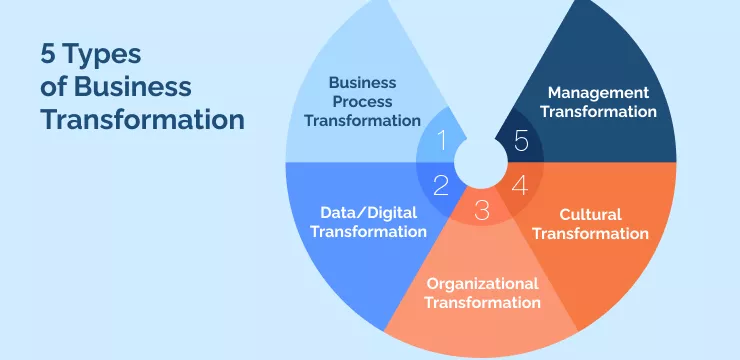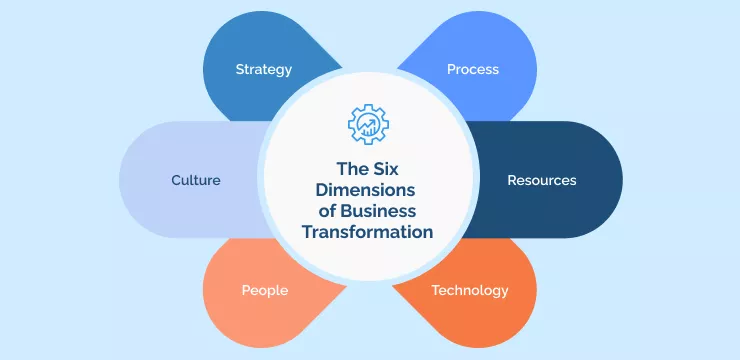
The economic upheaval caused by the COVID-19 pandemic is still resonating across industries, even with 2023 just over the horizon. The fallout of the global pandemic and additional volatility caused by the geopolitical tensions between Russia and Ukraine has forced businesses to undergo a rapid transformation to maintain marketplace perpetuity in uncertain economic times.
Change management is more important than ever for businesses to remain competitive, and the future of their success depends on how well they can adapt to new conditions. Companies will need to constantly review their strategies and ensure that they are consistently focused on the customer experience in order to remain successful.
Businesses should also strive to adopt an agile mindset when it comes to adapting to market changes and emerging technologies. Organizational change management is a top priority for businesses looking to stay ahead of the competition, as it allows them to remain flexible and responsive to changing customer demands.
Businesses also need to focus on developing an agile workforce in order to take advantage of technological shifts. An agile workforce is one that is able to quickly adapt and respond to changes in the market environment, allowing companies to pivot faster in order to remain relevant.
An Innosight study tracking corporate longevity found that S&P 500 companies are experiencing steady churn rates, with a high turnover paradigm of firms dropping off the index and becoming replaced with newer firms.
Trends like these show corporate lifespans are decreasing and driving business value in the digital age is becoming increasingly necessary. Moreover, the number of unicorn start-ups permeating the sector is increasing tenfold. This has put additional pressure on incumbent businesses to drive transformation efforts in an attempt to keep pace.
A business transformation project presents a bold opportunity for change, a chance to overhaul and realign long-held business models with the implementation of contemporary practices, processes, and operations.
Business transformation requires understanding future business requirements, a willingness to innovate and improve, and a propensity for informed decision-making on behalf of business and IT leaders.
COVID-19 accelerated changes to consumer and marketplace trends that were already in a state of flux pre-pandemic. As we move into 2023, transformation initiatives should be well within the purview of business leaders and executives seeking to increase the bottom line and remain relevant in the rapidly changing business landscape.
A 2022 McKinsey survey reports that eighty percent of CEOs consider business-building a top five priority despite the heightened economic volatility in recent years. This shows that digital transformation efforts are top priorities for businesses that wish to overhaul their business processes.
This article will delve into the intricacies of successful transformation, providing organizations with a clear and comprehensive guide for accelerating organizational change and the tools, tips, and resources needed to do so effectively.
What Is Business Transformation?
Business transformation is an umbrella term that refers to the process of revolutionizing a company–often to improve its financial and operational success. A business can reach new heights and elevate from its current status quo through fundamental alterations to personnel, processes, operations, and technology.
Business transformations are audacious and go a long way in inspiring agile teams. Far-reaching changes companies can make to increase progress and growth beyond typical minor developments. This covers a wide range of strategies, such as changing over to brand-new models of business or operations and introducing more innovative technologies to the workplace.
Business transformation also encompasses a company’s shift from analog to digital processes and adopting new philosophies in departments such as marketing, customer service, and more. Business transformation initiatives are often essential to remain competitive in the current market environment and provide a company with the necessary tools to respond and adapt quickly.
As organizations undertake business transformations, they should focus on customer-first strategies and emphasize collaboration between departments to ensure the success of their initiatives.
The business transformation process has become essential to gain a competitive edge. Companies can and will transform with the right resources, people, and technology. In 2023 and beyond, businesses will be able to stay ahead of the competition and thrive by investing in digital transformation initiatives.
The Value of Business Transformation

The value of business transformation is realized through improved operations and new developments.
Hence, business leaders often find that implementing business transformation initiatives brings advantages such as increased profit, improved customer experience, enhanced productivity, and increased business speed.
A good change manager understands that the nature of transformation efforts can require a shift in organizational culture. They should be able to motivate the organization to adopt new ways of working and thinking. Change managers should identify sources of resistance to transformation and provide strategies to overcome these obstacles, while helping the organization embrace new ways of working.
Achieving this may include cultivating prospective employee talent, leveraging intellectual property, repurposing proprietary technology, or maximizing business potential by introducing newer, more efficient operational models.
Business transformation can also support companies in being more agile, efficient, and cost-effective to keep up with changing customer demands. Business transformation is a long-term investment that yields solutions to pressing issues that may otherwise prove difficult to tackle.
By focusing on changes that can help a company attract and retain customers, increase profitability, or improve in other ways, organizations can gain tremendous advantages that will ensure their success for many years.
5 Types of Business Transformation

The five types of business transformation are as follows:
- Business Process Transformation
This type of transformation focuses on improving the efficiency and effectiveness of existing processes. It may involve streamlining operations, eliminating redundancies, and introducing newer technologies to improve output and reduce costs.
- Data/Digital Transformation
Data transformation optimizes an organization’s assets to create value and generate new business opportunities. Digital transformation involves leveraging digital technologies such as artificial intelligence, cloud computing, and the internet of things (IoT) to improve customer engagement and operational performance.
- Organizational Transformation
Organizational transformation is the process of changing how an organization operates. It may involve restructuring, merging departments, and introducing new policies and procedures to improve efficiency and productivity.
- Cultural Transformation
Cultural transformation refers to changing the attitudes and behaviors of an organization’s employees. It involves making changes that promote collaboration, customer focus, and innovation to drive long-term success.
- Management Transformation
Management transformation transforms management practices to create a more effective and efficient organization. This may involve introducing new performance metrics, developing better management techniques, and changing leadership styles.
The Six Dimensions of Business Transformation

Business transformation comprises six dimensions: strategy, process, resources, technology, people, and culture.
These dimensions are intertwined and must be considered when undergoing a business transformation initiative.
1. Strategy: The strategy dimension includes the organization’s vision and goals that define what the business should accomplish to achieve its objectives.
2. Process: The process dimension includes the tools and methods to plan and execute projects, activities, and operations.
3. Resources: The resources dimension includes financial assets such as budgets, physical resources, equipment, and materials needed to perform business operations efficiently.
4. Technology: The technology dimension involves leveraging digital technologies such as artificial intelligence (AI), cloud computing, the internet of things (IoT), automation, and analytics to improve operational performance.
5. People: The people dimension involves creating an environment where employees are empowered to think critically, solve problems creatively, and contribute positively to the organization’s mission and goals.
6. Culture: The culture dimension involves developing a company-wide culture of collaboration, customer focus, and innovation that encourages employees to think outside the box and deliver value.
Business transformation is essential for any organization that wants to stay competitive in today’s fast-changing business environment. By taking advantage of the various types of transformation and considering all six dimensions, organizations can drive innovation and unlock new value that will ensure their success for many years.
5 Business Transformation Initiatives:

The following are four initiatives organizations can use to guide their business transformation efforts:
- Incremental Transformation
Incremental transformation involves making small, gradual changes to existing processes and practices to improve performance. This type of transformation is ideal for organizations that want to make slow, steady progress toward their goals.
- Radical Transformation
involves making large-scale changes to the way an organization operates. It is best suited for organizations that need to make significant changes quickly to stay competitive or survive in a rapidly changing environment.
- Charged Transformation
Charged transformation involves introducing new technology or processes to an organization. This type of transformation is often used to enable innovation and unlock new sources of competitive advantage. Charged transformation initiatives can involve switching to cloud computing, introducing artificial intelligence (AI) into operations, and leveraging the internet of things (IoT).
- Negotiated Transformation
Negotiated transformation involves introducing organizational changes while considering the stakeholders’ concerns and needs. This type of transformation is ideal for organizations that need to make significant changes but may face resistance from some stakeholders.
- Seized Transformation
Seized transformation involves introducing changes imposed on an organization by external forces. This type of transformation requires a company to quickly and effectively adapt to environmental or market changes, such as regulations or technological advancements.
Organizations can identify the best approach for their specific needs and goals by considering the various types of business transformation initiatives. By taking a holistic view of the organization, leaders can ensure that their transformation efforts are aligned with the organization’s mission and strategy and that all stakeholders are on board with the changes.
Successful business transformation requires an integrated approach across all six dimensions. With a comprehensive plan in place, organizations can unlock new sources of value and create a competitive advantage that will keep them ahead of the curve in today’s ever-changing marketplace.
8 Tips To Help CIOs, CDOs, and IT Leaders Manage Transformation Efforts

The following tips can help CIOs, CDOs, and IT leaders effectively manage transformation efforts:
1. Identify the key drivers of change
Before beginning a transformation project, it is important to identify why the organization needs to transform. Understanding what is driving the need for change can inform the approach taken by IT and business leaders.
2. Assess the current state
Organizations should assess their current capabilities to understand where they stand regarding technology, processes, people, and culture. This information will give insight into what areas need improvement and how best to transform those areas.
3. Develop a comprehensive plan
Once the critical drivers of change have been identified and an assessment of the current state is complete, organizations should develop a comprehensive transformation plan. This plan should include the objectives to be achieved, the completion timeline, and the required budget.
4. Establish clear roles and responsibilities
Everyone involved in the transformation project must understand their roles and expectations. Establishing clear roles and responsibilities will ensure that all stakeholders work together towards a common goal.
5. Deploy technology strategically
Technology can be used as an enabler of business transformation initiatives. However, IT leaders must strategically deploy technology to maximize its effectiveness and ensure successful implementation.
6. Communicate progress regularly
Keeping stakeholders informed of progress throughout the transformation process is essential for success. Regular communication will help ensure everyone is on the same page and that potential problems can be addressed quickly and effectively.
7. Measure progress and outcomes
It’s essential to measure progress and developments to understand the effectiveness of transformation initiatives over time. This will help organizations identify areas for improvement and celebrate successes along the way.
8. Ensure employee buy-in
Transformations can often be met with resistance from employees if they need to be adequately prepared for the change or understand its purpose. To help ensure success, it is essential to obtain employee buy-in by engaging them in the process early on and providing them with adequate training and resources for the successful implementation of changes.
By following these tips, CIOs, CDOs, and IT leaders can create a successful plan for their transformation initiatives and achieve their desired outcomes. Organizations can unlock new sources of value and become more competitive with an effective strategy in today’s digital environment.
What Is Digital Business Transformation?
Digital business transformation is the implementation of digital initiatives as part of wider business practices. Digital business transformation is enhancing and evolving an organization’s operations, processes, culture, and technology to maximize business potential.
It involves reorganizing existing business models to leverage digital technologies such as cloud computing, artificial intelligence (AI), big data, analytics, and automation. Organizations can increase efficiency, reduce costs, and improve customer experience by digitally transforming their business operations with the technologies mentioned above.
The Importance Of Digital Business Transformation
Digital transformation is essential for organizations to remain competitive in today’s digital environment. As new technologies emerge and existing ones evolve, it has become increasingly crucial for businesses to adapt and innovate.
By transforming with the latest digital tools, companies can create new sources of value and unlock growth potential. Digital transformation initiatives can help reduce costs, streamline processes, increase customer satisfaction, and enable more efficient operations.
The need for digital transformation has become even more urgent in the wake of the COVID-19 pandemic. Businesses have had to adapt quickly to survive, and many have embraced digital technologies as a way to do so.
Therefore, organizations must invest in digital business transformation initiatives to succeed and exploit a sea of change.
Business Transformation Questions For Leaders

The following questions will help leaders create a successful plan for their digital transformation initiatives:
- How can we measure the impact of external disruptors on the business and adapt to leverage their potential?
- Will the R&D of our products and services meet future business demands?
- Who are the new competitors arising within the shifting industry landscape?
- How will you ensure change capabilities and demonstrate agility in times of economic uncertainty?
The Future Of Digital Business Transformation
The future of business transformation is one of ongoing innovation and adaptation. Organizations that invest in digital technologies and embrace change will be best equipped to remain successful as technology continues to innovate global business sectors.
Businesses must embrace digital transformation as part of broader business transformation efforts. This requires CIOs, CDOs, and IT leaders to understand the importance of such digital initiatives and develop a change management readiness checklist for success.
By identifying critical drivers of change, developing a comprehensive plan, establishing clear roles and responsibilities, deploying technology, communicating progress, measuring outcomes, and ensuring employee buy-in—organizations can successfully implement transformation initiatives and better compete in the evolving business arena.
Accelerating Business Transformation in 2023

Companies navigating the post-COVID economy are steadily embracing organized disruption to invoke business transformation. Opting for a “better, cheaper, faster” approach to improving productivity has long been a proven method for achieving business transformation.
However, emerging new and innovative technologies creates waves and upends traditional practices industry-wide. This has forced business and IT leaders to reassess their approach and only works to confirm an increasing adherence to adopting digital-driven solutions.
As such, business and IT leaders must re-examine and modernize legacy business practices—this may mean enhancing the technology portfolio as part of a digital transformation or investing in ESG initiatives that facilitate sustainable transformations.
Business and IT leaders must recognize shifting value within their industry and zealously commit to long-term transformation if true organizational change can occur. This requires business and IT leaders to do more than just set short-sighted goals and blindly invest. It also means communicating the value of change across the organization, developing new leadership skills, and personifying change as a demonstration of authentic leadership.
WalkMe Team
WalkMe spearheaded the Digital Adoption Platform (DAP) for associations to use the maximum capacity of their advanced resources. Utilizing man-made consciousness, AI, and context-oriented direction, WalkMe adds a powerful UI layer to raise the computerized proficiency, everything being equal.



